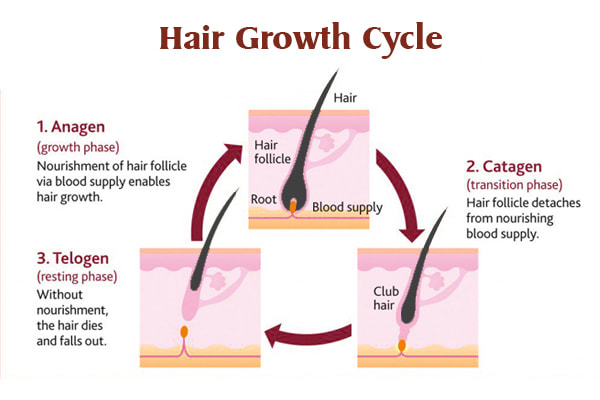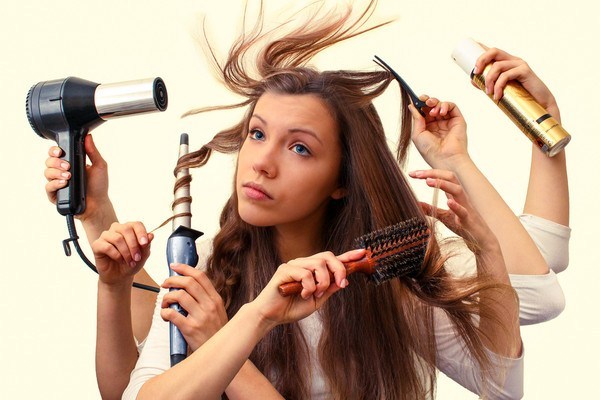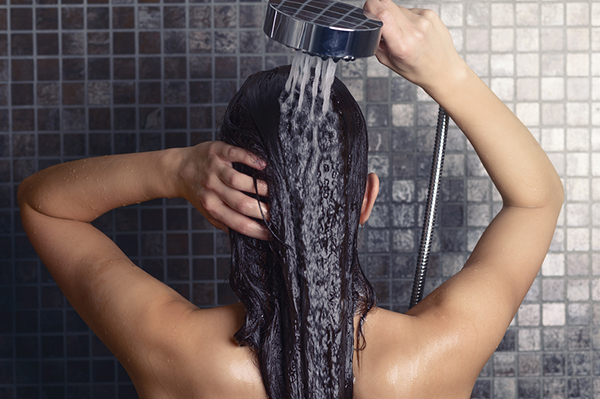Blog
Why Is My Hair Falling Out? Causes of Hair Fall and What To Do About It

We all have that moment of panic when we see a bunch of hair after brushing our hair or going for a shower. Hair fall or hair loss is one of the common concerns for both men and women as it affects their self-confidence. It can be frustrating and disheartening. Read more to find out some of the reasons why your hair falls out and what are some of the things you can do to prevent or alleviate it.
Why is your hair falling out?
Finding stray hairs on your brush or on the shower drain is not necessarily cause for alarm. An average adult head has about 150,000 strands of hair and sheds up to 50 – 100 of them a day. Sometimes we just have an increased awareness of our hair fall making us think something is wrong but hair fall is a natural part of the hair growth cycle.
The hair growth cycle has three stages. First is “anagen” or the growth phase. About 90% of our hair is in this stage which lasts between two to eight years. In this stage, the nutrients are supplied to the hair follicles and enable hair growth. The next stage is “catagen” or transition phase. This is when the hair follicle slowly shrinks and starts to detach from the nutrient supply. The final cycle is called “telogen” or the resting phase. At this time the hair is shed and the growing cycle starts again. Normally 5-10% of a person’s hair is in this phase at one time.

Image Source: Google
However, there are instances where the hair growth cycle is disrupted. In this case, you will experience hair loss. Instead of counting your hair fall per day, there are a few other ways to check if you are experiencing excessive hair fall:
- Your ponytail feels thinner or less bulky
- Your hair part is widening
- You notice reduced thickness in one area or throughout your scalp
What could be the reason for hair loss?
If your hair is constantly damaged and not taken care of properly, you may find that the hair will not grow as much as it used to. There are plenty of factors and triggers that might be the reason for your hair loss ranging from lifestyle choices to medical conditions and genetics.
1. Hair Styling
Hairstyling such as perming, bleaching, rebonding, ironing, curling and hair dyeing make hair weak and brittle and may be the reasons why you are experiencing hair loss. If not done by a professional, these may get over-processed causing further damage, and eventually, hair fall. The chemical components of these processes can also be harmful if not applied properly.
Some hairstyles such as cornrows, tight braid or ponytail also causes strain to the hair follicles and potentially cause hair loss because of the constant pull on the hair. These pulling force applied to the hair causes “traction alopecia” or gradual hair loss.

Image Source: flickr.com
What you can do: Professional hair stylists know the correct and proper way to handle hair in order to achieve the hairstyle you want. As much as possible, avoid doing it yourself to make sure the right products and procedures are used. For hairstyling that you can do at home such as ironing or curling your hair, always use heat protectants to lessen heat damage to the hair. It is also important to give your hair a break from these.
It’s best to alternate different hairstyles and leaving your hair down once in a while to reduce strain to the hair and scalp. Be wary of using hair accessories such as cheap hairpins, metal accessories or bare rubber bands because tend to snip and pull against the hair. You may use accessories that are smooth and soft such as fabric scrunchies.
It’s also good to note that when brushing your hair, you should start at the ends and work upwards. This way you brush out the tangles first and you won’t tug or pull too much on your scalp. After removing the tangles, apply full strokes from the scalp to the ends to distribute the hair’s natural oil.
2. Showering and Shampooing
You may have read or heard many times that shampooing your hair daily is bad for your hair. Some shampoo has ingredients that are harsh for a person’s scalp and hair, making it dry and strips its healthy oils. If you are the type of person who likes to style your hair and use different products, it may cause product build up if not cleaned regularly. Many volume-building hair shampoos contain paraffin which easily builds up and can make hair break.
Rubbing your hair with a towel after showering to dry it will also lead to breakage, tangles and pulling because the hair is at its most fragile when it is wet. Friction caused by rubbing is not helpful.

Image Source: hairscalp.com
What you can do: Simple as it is, the best practice is to shampoo and clean your hair when it is dirty. Not all shampoos are created equal so you have to look for a shampoo brand that will suit you. If it makes your hair too dry, it is most likely an indication that the shampoo contains a cleanser or detergent that is too strong for your scalp. If it’s too mild, it might not be effective to remove dirt, oil and product build-up. You will know it is a good shampoo if it can maintain a balance of effectively cleaning your hair but does not strip your natural oils. A good indication is that it is free of sulfates, silicone, synthetic fragrance, synthetic coloring, and paraben which can cause irritation, especially with sensitive scalps. Shampoos made with organic ingredients such as rosemary extract and keratin proteins are good for the hair as well. Many hair products, especially in Japan, have Silk Amino Acids (SAA) which boosts hair growth. SAAs are proteins that lock moisture into the hair and bind them together to give strength and improve elasticity. Combined with keratin which is a main component of hair, they form a protective layer and repairs damaged hair follicles. They are gentle and don’t pose allergies.
KIYOSA Japanese Total Beauty uses hair products imported from Japan! We also sell them to aid in maintaining you hair health.
Ales Color Murasaki Shampoo: P1,500
Nanoamino Shampoo: P1,400
Nanoamino Treatment:P1,850
Hyetal: P1,600
After showering, avoid brushing your hair when it is wet because that is when it is especially fragile. It is better to use a wide-tooth comb or even your hands to remove tangles. To dry your hair after showering, gently squeeze out excess water in your hair with the towel and let it dry naturally. Try not to blowdry your hair too much.
3. Diet
Hair is one of the fastest-growing cells in our body. However, it is not a vital organ or tissue which is why our body will not prioritize its nutritional needs. When we don’t get enough nutrients in our diet, it will most likely affect the hair growth cycle.

Image Source: drbeurkens.com
What you can do: A healthy diet is not only beneficial to your hair but for the rest of your body as well. Food rich in protein, omega-3, vitamins B6 and B12, and folic acid is great for achieving healthy hair. Good sources of protein are lean meats like fish and chicken, eggs and soy products. Food rich in Omega 3 are fish and oysters (salmon, mackerel, tuna, herring or sardines), nuts and seeds (flaxseed, chia seeds or walnuts), plant oils (flaxseed, soybean or canola oil) and fortified foods (eggs, yogurt, milk or soy beverages). Foods with vitamin B6 are bananas, potatoes, and spinach. Major sources of vitamin B12 are meat, poultry, fish and dairy products.
As mentioned earlier, amino acids are great for the hair and it is not only found in shampoos. Incorporating amino acids to your diet will play a major role in the production of red blood cells that supply nutrients to the hair, too. The most crucial amino acid for hair is called “cysteine” which is also an antioxidant that protects hair from sun damage. Major sources include broccoli, chicken, wheat, brussel sprouts and some dairy products like milk and yogurt.
4. Sunlight and UV Radiation
Research suggests that UV radiation is also a cause of hair damage because it degrades the protein that makes up the strands. While it won’t necessarily interrupt the hair growth cycle, it will weaken the hair fibers and cause dullness, frizz, and breakage thus affecting the health of the hair. However, those with thin hair are more susceptible to exposing their scalp too much to the sun and that can cause inflammation or damage leading to hair loss.

Image Source: Google
What you can do: Protect your hair from sunlight and other sources of UV radiation by wearing a hat particularly if you are going to be spending a large amount of time in the sun. There are available leave-in treatments that can protect your hair throughout the day, too.
5. Stress
Any number of stressful situations such as chronic illness, injury, relationship issues, financial concerns, poor nutrition, surgery or even jet lag can be a trigger for hair loss. The type of hair loss caused by physical or emotional stress is called “telogen effluvium.” In this, the hair follicles are forced to go to the resting stage and over time you will notice the hair will fall out more easily even if you are just washing, combing or touching it. Usually, there won’t be any noticeable difference in hair loss up until three months after the stressful event.

Image Source: Google
What you can do: The good news is, telogen effluvium doesn’t necessarily lead to lasting damage. The hair loss is a sign that new hair is growing again and should be apparent three to six months after initial shedding. So, relax! Avoid stressors or anxiety-inducing events as much as possible. Getting regular exercise helps manage stress and its effects because the body releases “endorphins” during this. Endorphins trigger a positive feeling to the body so not only will you look beautiful because of reduced hair loss, you will also feel good!
6. Hormonal Imbalance, Medical Conditions, and Genetics
There are instances where medical conditions and medications have hair loss as a side effect. A well-known example is during chemotherapy for cancer patients. Endocrine disorders such as Polycystic Ovarian Syndrome causes an excess of androgens which results in hair loss, too. Androgens are male hormones that are not hair friendly which is why balding is common for men.
For new moms, they might notice that before or during pregnancy their hair are thicker or more lustrous due to high levels of the hormone “estrogen” which slows hair shedding. But a few months following childbirth, they might experience a bit of hair thinning or excessive hair fall caused by the drop in estrogen. Another reason researchers point out is the physiological stress that comes with childbirth.
Other medical conditions such as anemia or “trichotillomania” which is a psychological condition where a person pulls out his or her hair because of anxiety can also be a reason for hair fall. “Alopecia” is a hair disease that occurs when the immune system attacks the hair follicles causing hair loss. It can occur even to healthy people.
Genetic or hereditary hair loss is also very common. They say for every five men with the condition, three women have it also.

Image Source: regroe.com.ph
What you can do: In these cases, the best way to deal with it is to consult a doctor. Your doctor will confirm whether it is hereditary hair loss or it is caused by an illness. He may recommend an over-the-counter medication like minoxidil, a topical hair loss treatment for moderate to severe cases. It is applied to the scalp and works on hair follicles to reverse the shrinking process and stimulate new hair growth. Just be wary of side effects which are minimal but may cause skin irritation.
As for the hair loss caused by child-birth, it is normal. The good news is that you are likely to regain normal growth between six to nine months. In the meantime, try to use shampoo or hair treatment that contains placenta which is good for hormonal imbalance. It also reconstructs protein and repair hair follicles while making the hair smooth and shiny.
Conclusion
There is no magic product or remedy in order to completely eliminate hair fall. It is only natural. It is a common issue for both men and women, so if you are losing hair, don’t freak out! Once you have done your part, be patient as it takes a few more weeks to see improvement. Your hair will eventually recover. You have to look to your overall health, lifestyle, and well-being in order to improve the condition of your scalp and promote the hair growth cycle. However, excessive hair fall is also a way of your body to tell you that there is something wrong. It is always better to consult a medical professional if the hair fall is obviously alarming as it might be an indication of an illness.
You may call our BGC branch to book an appointment. Please refer to their respective contact numbers below:
BGC branch – 0939-9158888 / 02-805-8888

